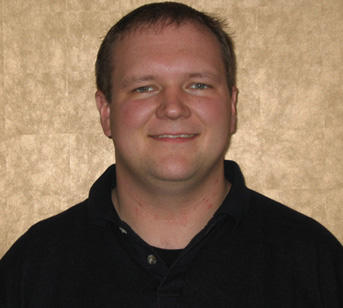
Joshua Puhl
Thesis Title:
Locomotion and its activation by dopamine in a simpler neural network
Current Position:
Professor, College of the Sequoias
Former Positions:
Post-Doctoral Research Fellow, National Institute of Neurological Disorders and Stroke in Bethesda, MD
Post-doctoral Research Fellow, CFAN Entomology, University of Minnesota
Undergraduate Institution and Major/Degree:
- Univ. of Wisconsin - La Crosse; B.S. Cell and Molecular Biology; 1998
- Univ. of Wisconsin - La Crosse; B.S. Microbiology; 1999
Major Advisor(s):
Karen Mesce, Ph.D.
Selected Publications:
- Puhl JG, Bigelow AW, Rue MCP, Mesce KA. Functional recovery of a locomotor network after injury: Plasticity beyond the central nervous system. eNeuro. 2018 Jul 11;5(4). pii: ENEURO.0195-18.2018.
- Mesce KA, Alania M, Gaudry Q, Puhl JG. The stomatogastric nervous system of the medicinal leech: its anatomy, physiology and associated aminergic neurons. J Exp Biol. 2018 Mar 29;221 (Pt7).
- Harley CM, Reilly M, Stewart C, Schlegel C, Morley E, Haider S, Puhl JG, Nagel C, Crisp KM, Mesce KA. Compensatory plasticity restores locomotion following chronic removal of descending projections. J Neurophysiol 2015;113:3610-3622.
- Puhl JG, Masino MA, Mesce KA. Necessary, sufficient and permissive: A single locomotor command neuron responsible for intersegmental coordination.J Neurosci. 2012;32(49):17646-57.
- Ferguson JE, Boldt C, Puhl JG, Stigen T, Jackson JC, Crisp KM, Mesce KA, Netoff TI, Redish AD. Nanowires precisely grown on the ends of microwire electrodes permit the recording of intracellular action potentials within deeper neural structures. Nanomedicine (Lond). 2012;7:847-53.
- Puhl JG, Mesce KA. Keeping it together: Mechanisms of intersegmental coordination for a flexible locomotor behavior. J Neurosci. 2010;30:2373-2383. (featured on Journal’s cover)
- Puhl JG, Mesce KA. Dopamine activates the motor pattern for crawling in the medicinal leech. J. Neurosci. 2008;28(16):4192-4200
Awards and Honors:
- 3M Graduate Fellowship; 2004-2008
- NIH Neuro-physical computational interdisciplinary graduate traineeship; 2005-2006, 2006-2007
- Ruth L. Kirschstein Pre-doctoral NRSA Fellowship, National Institute of Neurological Disorders and Stroke, University of Minnesota, Twin Cities, 2008-2009, 2009-2010
- Richard Poppele Award, 2008
- Doctoral Dissertation Fellowship, Graduate School, University of Minnesota, Twin Cities, 2008-2009
- Heiligenberg Travel Award, International Society for Neuroethology, 2007
Professional Memberships:
- Society for Neuroscinece, since 2005
- International Society for Neuroethology, since 2005
- Civil Air Patrol since 1988
Research Description:
One of my principle goals as a neuroscientist is to understand how the activities of neural networks give rise to behaviors. I find the notion of behaviors being elicited through the coordinated firing of networks of nerve cells fascinating. It was this idea that ultimately lead me to pursue neuroscience as the focus of my graduate school studies. Since matriculating into the graduate program in neuroscience, my fascinations have grown both in breadth and depth.
My graduate studies focus on learning how locomotor neural networks function. More specifically, I want to learn about the circuitry of locomotor pattern generating networks and how they give rise to dynamic locomotor behaviors. The model system that I use for these studies is the European medicinal leech, ( Hirudo species ) . The leech is an almost ideal system for studying locomotion for several reasons: 1) The entire CNS is comprised of about 10,000 neurons making it a vastly simpler system compared to the CNS of the vertebrates, 2) Locomotor behaviors of the leech are easily separable and quantifiable and 3) The cells of the CNS are easily accessible, large in size (relative to cells of the CNS of the vertebrates) and most importantly uniquely identifiable.
The major experimental trajectories for my thesis research program include:
- Describing dopamine's (DA) ability to activate fictive crawling in isolated CNS.
- Determining the CNS components involved in the coordination of the segmental central pattern generators (CPGs) for crawling.
- Characterizing the constituents of the CPG for crawling in the leech.
- Investigating how DA changes the activity of identified neurons within the leech CNS (segmental ganglia and cephalic/tail ganglia) and the resulting ramification on locomotor behaviors.
- Describing the neurochemical changes of the DA system after treatment with antipsychotic drugs.
The primary experimental techniques that I employ are electrophysiology (intracellular and extracellular), immunocytochemistry, behavioral monitoring, nearly-intact preparations and voltage-sensitive fluorescent dye imaging.
Lab Rotations:
- Geoff Ghose
- A. David Redish
- Teresa Nick
- Karen Mesce
Courses Taken Beyond the Core Courses:
- NSC 5202 - Theoretical and Systems Neuroscience
- EEB 5963 - Modeling Nature and the Nature of Modeling
- STAT 5021 - Statistical Analysis
- GRAD 8101 - Teaching in Higher Education
Graduate Level Minor:
- Supporting program focusing on scientific computation and theoretical neuroscience.
Conferences Attended and Presentations:
- Society for Neuroscience, Annual Meeting - 2004, 2005, 2006
Committee Members:
- Mark Masino (Neuroscience)
- Karen Mesce (Entomology/Neuroscience)(advisor)
- Teresa Nick (Neuroscience)
- Duane Nykamp (Math)
- Richard Poppele (Neuroscience)
- A David Redish (Neuroscience)(chair)
Home Town:
- Burnsville, MN
